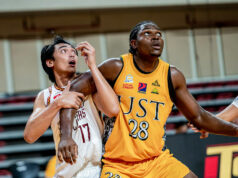Aeroflot Open
Moscow, Russia
Feb. 19–27, 2020
Final Top Standings
1–4. IM Aydin Suleymanli AZE 2474, GM Rinat Jumabayev KAZ 2646, GM Rauf Mamedov AZE 2643, GM Aravindh Chithambaran (IND 2630, 6.5/9
5–10. GM Aleksej Aleksandrov BLR 2592, GM Vugar Asadli AZE 2538, GM Adhiban Baskaran IND 2654, GM Manuel Petrosyan ARM 2590, GM Mustafa Yilmaz TUR 2607, GM David Paravyan RUS 2629, 6.0/9
Total Participants: 97 players
Time Control: 100 minutes for the first 40 moves, then 50 minutes for the next 20 moves, followed by 15 minutes play-to-finish with 30 seconds added to your clock after every move starting move 1
The Aeroflot Open was a huge gathering of very strong players and naturally a lot of beautiful chess was played. Here is my favorite game from the event.
Puranik, Abhimanyu (2597) — Sjugirov, Sanan (2674) [A07]
18th Aeroflot Open-A 2020 Moscow (5.7), 23.02.2020
The 20–year-old GM from Maharashtra, India, Abhimanyu Puranik, is known for his tactical radar which allows him to find his way through even the most chaotic positions. In the following game though he gets outplayed by the pride of Kalmykia Sanan Sjugirov.
Ten years ago Sjugirov was creating waves and became one of the youngest ever to qualify for the Russian SuperFinals at the age of 16 (this was in 2009). He has lost a bit of momentum since then but still remains a tough customer. Take a look at what he did to Puranik.
1.Nf3 d5 2.g3 g6 3.Bg2 Bg7 4.0–0 e5 5.d3 Ne7 6.e4 0–0 7.exd5 Nxd5 8.Re1 Nc6 9.Nc3 Nde7 10.Rb1
The usual move here is 10.a4. This move, planning b2–b4, was considered bizarre when it was first used around 2015. However, Magnus Carlsen started using it too in 2017 and now it is considered main line theory.
10…a5
Right away Black prevents b2–b4.
11.b3 Nf5 12.Nb5 Re8 13.Bb2 a4 14.bxa4
A bit of a strange move. Interesting is 14.b4 with the follow-up to be a2–a3. Black cannot take the pawn because of 14…Nxb4 15.Bxe5! Bxe5 16.Rxb4 Black’s position is awkward. For example the bishop cannot even retreat to g7 due to 16…Bg7 17.Rxe8+ Qxe8 18.Nxc7 White has won material.
14…Rxa4 15.a3 Ra8 16.c4 Nd6
Planning …e5–e4 to target the c4–pawn.
17.Qb3 Bf5 18.Rbd1 Qd7 19.a4 Rad8 20.c5 Be6!
This is the start of some mind-bending tactics.
21.Qa3 Nc4! 22.dxc4
White doesn’t have the luxury of declining the sacrifice. 22.Qb3 Nxb2 23.Qxb2 e4 Black is clearly winning due to the discovered attack against the queen.
22…Qxd1! 23.Nxc7!
Taking the queen is taboo: 23.Rxd1? Rxd1+ 24.Bf1 Bh3 Is White about to be mated? No, for he can still defend with 25.Nd2 Rd8! (25…Rxd2?? 26.Bxh3 of course leaves White ahead on material) 26.Nd6! cxd6 27.Qb3 (the only defense, attacking the rook on d1) 27…Re1 (…Bh6 is coming) 28.f3 Bxf1 29.Nxf1 dxc5 30.Kf2 Rdd1 31.Ne3 Rb1 32.Qc3 Nb4 it looks like additional material losses cannot be prevented.
23…e4!
Opening up the long diagonal severely strains White’s defenses.
24.Nxe8
Let’s take a look at the alternatives:
24.Rxd1? Rxd1+ 25.Bf1 Bh3 26.Nd2 Rd8 27.Nd5 Rxd2 28.Bxh3 (28.Bxg7 Rd1 29.Ne3 Rxf1+ 30.Nxf1 Rd1 31.Qa1 Rxf1+ 32.Qxf1 Bxf1 33.Bc3 Bxc4 with an easily won endgame) 28…Rxb2 with Bd4 and Ne5 coming up;
On the other hand 24.Bxg7 exf3 25.Qc3 Re7 seems to hold for White.
24…exf3 25.Bc3?
[25.Rxd1 Rxd1+ 26.Bf1 Bxc4 (whether this bishop goes to c4 or h3 White’s reply will be the same) 27.Qa1! and now both sides will have to settle for a draw after 27…Rxa1 28.Bxa1 Bxf1 29.Bxg7 Ba6]
25…Rd3?
An inexactitude. Much stronger is 25…Nd4! (with the idea of Ne2+) 26.Bf1 (26.Rxd1? loses quickly: 26…Ne2+ 27.Kf1 Rxd1+ 28.Be1 Bxc4 the end) 26…Nc2 27.Rxd1 Rxd1 28.Qb2 Bh3 finishes off White.
26.Rxd1 Rxd1+ 27.Bf1 Bxc3
[27…Bh3 28.Qa1! holds]
28.Qb3?
He cannot take the bishop — 28.Qxc3? Nd4! forces White to give up his queen for the knight as otherwise …Ne2+ leads to mate.
However, even at this late stage White still has a defense. 28.h3! Nd4 29.Nf6+ Kg7 30.Ne8+ Kg8 (30…Kh6 is scarier but also leads to perpetual check 31.c6! Ne2+ 32.Kh2 Rxf1 33.Qf8+ Kh5 (33…Kg5? 34.Qc5+ Kh6 35.Qe3+ g5 36.h4! the tables are turned and it is now White who wins) 34.Qc5+ g5 35.h4 h6 36.Qe3 Bg4 37.cxb7 Rg1 followed by checking on g2 and g1) 31.Nf6+ Kg7 32.Ne8+ Kg8 draw.
POSITION AFTER 28.QB3
Now we get to see Sjugirov’s idea.
28…Rxf1+! 0–1
The Chessbase website <www.chessbase.com> has a facility where all the games are automatically analyzed by their chess engine. Anyway, after 28…Rxf1+! it indicated that White lost with the comment “lost on time?” The question mark means that it does not understand why White lost.
If it had thought a bit longer though then perhaps it would have noticed that Black has a beautiful forced mate in 7 here: 29.Kxf1 Bh3+ 30.Kg1 Nd4! 31.Qxc3 (31.Nf6+ Kh8 32.Qd1 Ne2+) 31…Ne2+ 32.Kh1 Bg2#
The list of the youngest chess grandmasters in history is frequently changing. When the World Chess Federation (FIDE) was reorganized after World War II it set up rules for the granting of international titles and, in 1950, came awarded the Grandmaster title to 27 players. The youngest in that list was David Bronstein who was 26 years of age. Bobby Fischer held the distinction of “youngest GM in history” when he became a GM in 1958 at the age of 15 years, 6 months, 1 day. It was 33 years later, in 1991, that Judit Polgar broke his record by a month. Three years later it was broken again by another Hungarian prodigy, Peter Leko and 3 years later the Frenchman Etienne Bacrot lowered the record to 14 years and 2 months. Then came Ruslan Ponomariov, then Bu Xiangzhi and finally in 2002 Sergey Karjakin set the bar at 12 years and 7 months, and his record still stands up to today.
Currently the five youngest GMs in history are:
Sergey Karjakin (Ukraine/Russia), 12 years seven months,
Dommaraju Gukesh (India), 12 years, seven months, 17 days
Javokhir Sindarov (Uzbekistan), 12 years, 10 months, five days
Praggnanandhaa Rameshbabu (India), 12 years, 10 months, 13 days
Nodirbek Abdusattorov (Uzbekistan), 13 years, 1 month, 11 days
Never heard of Sindarov? Early in 2018 people were just starting to mention a great new talent in Uzbekistan when he suddenly achieved all of the required three norms within a 4-month span. Two years later in the 2020 Aeroflot Open he is still very young, all of 14 years old, and he took down his compatriot GM Rinat Jumabayev.
Sindarov, Javokhir (2537) — Jumabayev, Rinat (2646) [B88]
18th Aeroflot Open-A 2020 Moscow (1.8), 19.02.2020
1.e4 c5 2.Nc3 d6 3.Nge2 Nf6 4.d4 cxd4 5.Nxd4 a6
We have transposed to the Sicilian Najdorf.
6.a3!?
Ever since players like Magnus Carlsen, Sergey Karjakin and Vishy Anand started playing 6.a3 against the Najdorf it is quickly gathering steam. It is basically a waiting move and in some cases it provides the a2–square for the light-squared bishop.
6…e6 7.Bc4 Nc6 8.0–0 Be7 9.Ba2 0–0 10.Be3 Nxd4 11.Bxd4 b5 12.f4 Bb7 13.Qd3 Rc8 14.Rae1 Qc7 15.f5 e5 16.Bf2 d5 17.exd5 Rfd8 18.Bg3 Nxd5 19.Bxd5
Not so good is 19.Bxe5?! Qb6+ 20.Bd4 (20.Kh1? Nf4 discovering an attack on the white queen as well as on g2) 20…Bc5
21.Ne2? Ne3! 22.Qxe3 Rxd4 23.Kh1 Rg4 Black is clearly winning;
21.Bxc5 Qxc5+ 22.Rf2 Nf6 23.Qg3 Re8 the initiative is worth more than the pawn given up;
21.Nxd5 Bxd4+ 22.Kh1 Rxd5 (22…Bxd5? 23.Bxd5 Rxd5 24.c3 white wins back the piece) 23.Bxd5 Bxd5 24.c3 Qc6! 25.Qxd4 Bxg2+ 26.Kg1 Bxf1 27.Rxf1 Re8 Black’s better pawns give him the superior game.
19…Bxd5 20.Bxe5
[20.Nxd5 makes it easy for Black. After the exchanges 20…Qc5+ 21.Bf2 Qxd5 22.Qxd5 Rxd5 23.Re2 f6 Black has control of the d-file]
20…Bc5+?
Correct was 20…Qc5+! 21.Rf2 (21.Bd4 Bc4! 22.Bxc5 Bxc5+ 23.Kh1 Bxd3 24.cxd3 Bxa3) 21…Bh4! 22.Bg3 Bf6 with Black clearly superior. However, Jumabayev had latched on to a tactical idea which had a flaw. We will see later how it went.
21.Kh1 Bxg2+
Black continues with his idea.
22.Kxg2 Rxd3 23.Bxc7 Rd2+ 24.Kh1 Rxc7?
Jumabayev’s idea. He already has a rook on the second rank and there is no back rank threat because he can defend it with …Bf8. Sadly, there was a hole …
25.Re8+ Bf8 26.Ne4! 1–0
Alas! After 26.Ne4 Rdxc2 there follows 27.Nf6+ gxf6 28.Rg1+ Kh8 29.Rxf8#
Don’t feel too bad for Jumabayev, as he just shrugged off this loss and scored five wins and three draws from the remaining eight rounds to tie for first.
Bobby Ang is a founding member of the National Chess Federation of the Philippines (NCFP) and its first Executive Director. A Certified Public Accountant (CPA), he taught accounting in the University of Santo Tomas (UST) for 25 years and is currently Chief Audit Executive of the Equicom Group of Companies.



